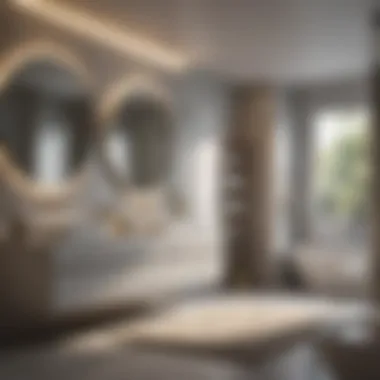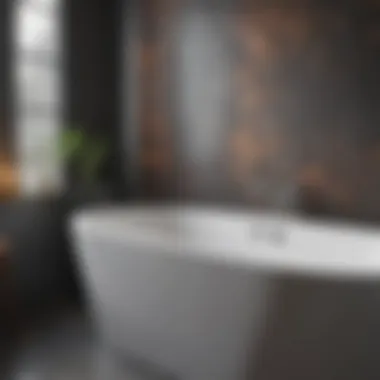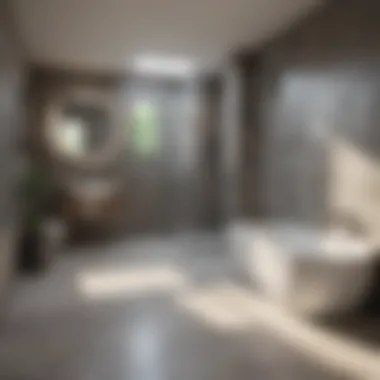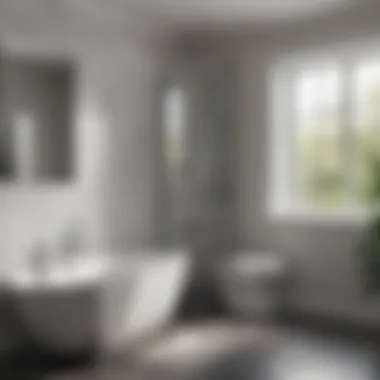Average Costs of Hiring Bath Fitters Explained


Intro
When it comes to sprucing up your home, bathrooms can often be neglected. However, they play a crucial role in our daily lives. Not just functional spaces, they should also provide comfort and a touch of style. Enter bath fitters, professionals who specialize in transforming bathroom spaces, but what might this transformation cost you? Understanding the average price for bath fitting services is essential for any homeowner or housewife venturing into renovation.
Budgeting for such projects can feel like navigating a labyrinth. There’s a lot to consider—from the materials that align with your vision to labor costs. Let’s break down the various elements influencing prices and give you a clearer picture.
Design Inspirations
Latest Trends in Bath and Bedroom Design
Design is an ever-evolving art, and bathrooms are no exception. Nowadays, minimalistic aesthetics with sleek lines that create a sense of tranquility are in vogue. Think of understated elegance with soft textures and smart accessories; it’s like a breath of fresh air amidst the chaos of daily life.
Freestanding bathtubs, bold backlit mirrors, and eco-friendly fixtures are not just trends, they reflect a shift towards making your space both beautiful and practical. House fitters can guide you in selecting items that meet your style while ensuring they are high quality and within your budget.
Color Palettes and Themes
Choosing the right colors can transform a dull bathroom into an inviting retreat. Lighter hues, such as soft grays and whites, can make a small space feel larger, while darker shades bring depth and drama. Consider all-time favorites like navy blue or deep green for a contemporary look. These color choices needn’t break the bank but can significantly impact the overall feel of the space.
An effective strategy is to create a mood board. This can be a collection of images, textures, and colors that reflect your vision. The bath fitter can then assist by sourcing materials and designs that resonate with your chosen theme.
Functional Elements
Space Optimization Tips
As bathroom spaces can often be limited, you'll want to think creatively about organization and function. A bathroom's layout should be efficient, combining aesthetics with practicality. Utilizing vertical storage solutions or multi-functional fixtures, like vanity units that hide away clutter, can save space and make the area feel more open.
Multi-Functional Furniture Choices
In a quest to maximize utility, consider incorporating multi-functional furniture. For instance, storage benches or vanities with hidden compartments can serve dual purposes, allowing for both seating and storage. This not only beautifies the space but also enhances its utility without overwhelming it.
"Investing in smart design choices today can lead to fewer headaches and expenses in the future."
In the end, understanding the prices of bath fitters also includes being aware of how design inspirations and functional elements can lead to a harmonious bathroom. It’s this thoughtful integration that often justifies the cost, making investments in these spaces not just purchases, but meaningful enhancements to your home life.
Overview of Bath Fitters
Understanding the role of bath fitters in home renovation is crucial for homeowners, especially those considering a bathroom makeover. Bath fitters simplify the often-daunting process of transforming a bathroom, providing a streamlined solution that merges efficiency with affordability. Their expertise can turn a lackluster bathing area into a soothing retreat, avoiding the mess and delay commonly associated with traditional renovations.
Definition of Bath Fitters
In essence, bath fitters are professionals who specialize in installing bath systems, including tubs, showers, and various plumbing elements. Unlike traditional contractors who may manage an entire renovation project, bath fitters typically concentrate on the replacement of bathing components with ready-made products that fit over existing structures. This method not only minimizes the time spent on a project but also reduces the amount of excavation and demolition work involved. Commonly, they utilize materials like acrylic and fiberglass designed to last and provide a fresh look with minimal hassle.
Common Services Offered
Bath fitters provide a range of services that cater to different needs and preferences. These generally include:
- Tub and Shower Installation: Replacing old tubs or showers with new models that might include modern features like non-slip finishes or integrated shelving.
- Wall Surrounds: Installing durable, easy-to-clean wall systems that complement new or existing fixtures.
- Custom Fitting: Tailoring installations to fit unique bathroom layouts, which may sometimes include additional plumbing work.
- Remodeling Consultations: Offering expert advice on how to maximize space, enhance aesthetics, and ensure practicality in the design.
- Ongoing Maintenance: Some bath fitters provide follow-up services to ensure everything functions correctly, preserving investments made by homeowners.
With their focused approach, bath fitters enable property owners to modernize their spaces effectively. The integration of these services plays a significant role in determining pricing, making it essential for homeowners to grasp what these professionals bring to the table.


The Average Cost Breakdown
Understanding the cost of bath fitters is imperative for homeowners considering a renovation. This section will shed light on critical elements that make up the broader picture of expenses related to bath fitting. In essence, knowing where your dollar goes helps manage expectations, preventing any financial hangovers down the road.
By breaking down the costs into manageable pieces, one can see the interplay between materials, labor, and customizations. Each factor plays a distinctive role in shaping the overall price. Furthermore, recognizing these elements not only aids in planning but can also empower the decision-making process, ultimately steering homeowners towards more informed choices.
National Averages
When it comes to bath fitters, averages can be your best friend. Across the United States, the average cost can hover around $5,000 for a standard bath fitting job. This figure varies significantly based on variables like the layout of the bathroom and the specific services included.
So, what contributes to this number? Typically, it comprises the costs of materials, labor, and additional fees that can pop up like weeds. For instance, a basic installation might fall under this average range, but adding custom designs or specific materials could lead the bill to skyrocket. Understanding these averages gives a grounding point for budgeting.
Cost Variations by Material Type
The type of material selected for bath fitting can sway costs in a heartbeat. Each material carries distinct characteristics that affect not only price but also durability and aesthetic appeal.
Fiberglass
Fiberglass is often touted for its lightweight and affordable nature. Being easy to mold allows for a variety of styles, making it a favorite among many homeowners.
- Key characteristic: Its resilience against chipping or cracking.
- Benefit: The budget-friendly appeal can make it an excellent entry point for those wary of overspending on a single upgrade.
- Unique feature: Fiberglass's surface is often easier to clean than other materials, thus lowering long-term maintenance costs.
However, it’s essential to note that while fiberglass fits snugly in the budget-conscious category, it may not hold the same luxurious feel as more premium materials.
Acrylic
Much like Fiberglass, acrylic is another lightweight contender. Known for its maintaining vibrancy over time, acrylic can also be molded into various designs.
- Key characteristic: It has a smoother surface, giving it an eye-catching sheen that blends beautifully with home aesthetics.
- Benefit: This material usually provides better insulation compared to fiberglass, which might help in lowering utility bills over time.
- Unique feature: Repairing minor scratches in acrylic can be simpler than with other surfaces, extending its lifespan.
On the downside, if not maintained properly, it can get yellowed over time.
Porcelain Enamel
Porcelain enamel stands out with its shiny and classic look. Its composition offers a more traditional feel, often adding value to your home should you decide to sell.
- Key characteristic: Its glossy finish adds a touch of elegance to any bathroom.
- Benefit: It is quite scratch resistant, which is crucial for daily use and can remain resilient for years if well taken care of.
- Unique feature: Unlike plastic-based materials, it won’t fade easily since it is often layered over steel.
Nevertheless, this premium aesthetic does come at a price and often exceeds the budgets of average homeowners.
Labor Costs and How They Affect the Total
Labor costs can sometimes feel like a hidden layer of pricing that sneaks up on you. Generally, hiring a skilled installer can range from $50 to $150 per hour, depending on their experience and the complexity of the project.
- Consideration: Remember, quality labor can save you from headaches in the future. It may be tempting to go for the lowest bid, but if cuts are made here, it could lead to extra costs later due to poor installation.
- Labor impact: Labor can account for nearly 30-50% of the total project cost. Understanding this enables one to allocate the budget wisely. Careful consideration might lead you to save money without compromising the overall quality of your renovation.
It’s crucial to factor in both materials and labor when considering your budget. The decisions made in these areas can significantly shape your final expenses.
In summary, the costs associated with bath fitters can vary dramatically based on a range of influences, from average pricing to specific materials used. A clear understanding of this breakdown can serve as an essential guide to navigate through the often murky waters of renovation budgeting.
Factors Influencing Pricing


When evaluating the costs associated with bath fitters, it's crucial to understand the various factors that play a significant role in determining the overall pricing. Pricing isn't simply a number; it reflects multiple components that impact how much one may end up spending. Let’s break down these factors to provide clarity on the pricing landscape for bath fitting services.
Custom vs. Standard Fitters
Choosing between custom and standard bath fitters can greatly affect the cost of your project. Custom fitters are tailored exactly to your needs, which can be a mixed bag concerning your budget. They offer unique designs that match your specifications, but this comes at a premium price. For example, if you desire a specific size or style that isn't readily available, you may need to pay more for the materials and labor required to achieve that perfect fit.
On the flip side, standard fitters are generally more budget-friendly. These are pre-manufactured designs available in set sizes. Opting for a standard fitter can lead to significant savings, particularly for those working within a tight budget. Keep in mind though, the choices may be limited, which could affect the overall aesthetic of your bathroom.
"Budget is always a tightrope walk when planning renovations. Finding the right balance between custom and standard fitters is essential to getting the most bang for your buck."
Regional Pricing Trends
Pricing for bath fitting services also varies significantly by region. In urban areas, where the cost of living is generally high, you can expect to pay more for bath fitting than in rural settings. Additionally, local market trends and competition greatly affect costs. In a bustling city like San Francisco, labor and materials can run much higher compared to a quieter town in Ohio.
Moreover, certain regions might have a stronger demand for specific materials or styles, thus influencing prices even further. For instance, homeowners in coastal areas may lean towards materials that withstand humidity, impacting their overall budget. Getting estimates from local fitters can provide a realistic view of what to expect in your specific area.
Size and Layout Considerations
The size and layout of your bathroom are pivotal when discussing costs. A compact bathroom will naturally require less material compared to a larger space, which can keep expenses down. However, if you need a more extensive layout change involving plumbing adjustments, the expenses can add up quickly.
If your space is awkwardly shaped, it may require additional labor and specialized materials to ensure a seamless fitting. Here are a few considerations:
- Square footage: Larger areas typically need more materials.
- Pipe relocations: These can hike up labor costs.
- Accessibility: Difficult layouts might require specialized equipment.
In summary, when contemplating bath fitting projects, it's essential to factor in the specific factors influencing pricing. From the choice of custom or standard fitters to understanding regional pricing trends and considering the implications of size and layout, each component plays a vital role. By taking a closer look at these aspects, you can better navigate through the financial aspects of your bath renovation and make informed decisions that align with your budget.
Comparative Analysis of Bath Fitters and Traditional Renovations
In the realm of home improvement, evaluating the financial implications of bath fitting services against traditional renovations is crucial for informed decision-making. Homeowners today face a myriad of choices when it comes to upgrading their bathrooms, and understanding these options aids in optimizing both budget and expectations. Some of the key aspects to consider include convenience, time efficiency, and overall cost.
Pros and Cons of Bath Fitters
When weighing the benefits and drawbacks of utilizing bath fitters, one must look beyond just the immediate price tag. Here’s an in-depth look:
Pros:
- Speedy Installation: Bath fitting typically involves a quicker installation process, often completed in a day or two. This means less disruption in your daily routine.
- Less Mess: Unlike traditional renovations, which can leave your house in a state of disarray for weeks, bath fitters often create less dust and overall mess.
- Tailored to Your Needs: Many bath fitters offer custom solutions, allowing you to ensure your new installation perfectly matches your vision.
- Durability: Fitted baths are often made from long-lasting materials, which might save homeowners in the long run when it comes to maintenance and replacement.
Cons:
- Limited Personalization: While custom options exist, they may not match the extensive personalization choices available in traditional renovations. Some homeowners may feel boxed in by pre-made designs.
- Potential Cost Overruns: Though advertised prices may seem attractive, unexpected fees can emerge, particularly if extensive plumbing or electrical work is needed.
- Quality Variability: With many fitters out there, the quality of service can differ widely. Not all companies will deliver the same standards of craftsmanship.
Cost Effectiveness Over Time
The question of whether bath fitters prove more cost-effective compared to traditional renovations is often debated. Here are some thoughtful points to consider:
- Initial Investment vs. Long-Term Value: Bath fitters might require a lower upfront cost but ensure to calculate the potential longevity. Traditional renovations, though pricier at the start, could yield a higher return on investment, especially in older homes.
- Maintenance Costs: Baths fitted from quality materials tend to have fewer upkeep costs, which can be a boon for budget-conscious homeowners. Factor in warranty and servicing costs when considering the long haul.
- Energy Efficiency: Many modern bath fitting services offer energy-efficient options which can reduce utility bills. Over time, these savings can stack up significantly.
In summary, a comparative study of bath fitters and traditional renovations demands weighing various factors—speed, cost, and the long-term implications of your choices. Homeowners are encouraged to analyze their particular needs and budgets, bridging the gap between immediate satisfaction and future benefits.


Budgeting for Bath Fitting Projects
Budgeting is a critical aspect when it comes to making any home improvement. It’s not just about setting aside a chunk of change; rather, it's about understanding the full financial scope of your bath fitting project. Knowing how to budget effectively can save not only money but also the headache of unexpected expenses along the way.
Planning a budget necessitates a clear grasp of the costs involved, including materials, labor, and potential extras. Bath fitters can provide a level of customization and quality that traditional renovations might not, but this can add to the expense. A thoughtfully crafted budget means you can allocate your resources thoughtfully and avoid being caught off guard by unforeseen charges.
Setting a Realistic Budget
When creating your budget, it’s essential to be honest about what you can afford and what you need. Start by researching the average costs of materials and labor in your area. Here are some steps to help set a realistic budget:
- Assess Your Needs: Identify what you want in your bathroom. Is it simply a fresh look, or are you aiming for a complete overhaul?
- Research Prices: Check local bath fitter services and their typical rates. This will help ground your expectations.
- Include Buffers: Always add around 10-15% more to your budget for those pesky unexpected costs.
By taking these steps, you can forge a budget that not only meets your expectations but is also comfortably within your means.
Hidden Costs to Consider
Budgeting isn't merely about the visible price tag; hidden costs can creep up and derail your plans if you’re not vigilant. These can include:
- Permits: Local regulations often require permits for bathroom renovations which may come at a fee.
- Old Material Removal: The cost to dispose of old materials can catch you off guard.
- Plumbing Adjustments: Changing the fittings may require additional plumbing work, leading to higher labor charges.
- Unexpected Repairs: You might find water damage or mold that you didn’t notice during the initial planning stages.
It's a good practice to always budget for the unexpected, as preparation is key to a successful project.
Financing Options Available
If your budget feels stretched thin, various financing options can ease the burden. Options to explore include:
- Home Improvement Loans: These loans are often tailored specifically for renovations and can be a great way to fund your project.
- Credit Cards: If you are comfortable with the interest rates, this can be a quick way to pay for smaller expenses.
- Personal Loans: Depending on your credit score, personal loans can be another route to consider.
- Manufacturer Financing: Some bath fitting services offer financing plans, which can be appealing if you are committed to a specific service provider.
Understanding these options can help ensure you have the funds necessary without spiraling into debt. The right plan allows you to focus on transforming your space instead of stressing about finances.
The End
Why is this important?
Grasping the financial implications allows homeowners and housewives to plan aptly, preventing future surprises. It’s vital to recognize that upfront costs may only skim the surface of the total expenditure. As we dissected the various components of pricing throughout this article—be it material choices, labor costs, or regional variations—it becomes clear that each factor plays a pivotal role in the final bill you will face.
Benefits of Understanding Bath Fitting Pricing
- Informed Decisions: Knowing the average costs empowers you to choose fitting services that align with your budget. You'll be less likely to be swayed by companies that promise the moon at steep prices.
- Budgeting Wisely: With insights into hidden costs or unexpected charges, you can set a realistic budget from the get-go, making sure there’s a buffer for those minor adjustments that tend to crop up during renovations.
- Value for Money: Assessing costs in relation to the benefits of bath fitters can help you ascertain if you're truly getting your money's worth.
- Long-Term Planning: Understanding how to maintain or improve your investment in bath fittings can lead to better savings and functionality down the road.
Considerations for the Future
Everything discussed surfaces the importance of planning and investing time to analyze the information pertaining to bath fitters. Querying the initial costs along with long-term benefits might seem like pie-in-the-sky thinking, but it’s crucial for outcomes that meet expectations. As with any substantial investment in your home, knowing what you’re getting into allows you the peace of mind to move forward confidently.
"If one doesn't plan ahead, one plans to fail." - An adage that holds true in home renovations as well.
In the end, the conclusion drawn here not only enriches your comprehension of bath fitting costs but also equips you with the necessary tools to ensure that your financial journey in the renovation arena is a savvy, informed, and ultimately satisfying one.
Final Thoughts on Pricing for Bath Fitters
In wrapping things up, it’s evident that inquiries into the average costs of bath fitters extend beyond a simple price tag. The richness of this subject unfolds through the interplay between various factors, each of which impacts the overall experience.
Homeowners should strive to take an active role in this process. By exploring everything from material selections to regional pricing trends, they can foster an environment conducive to wise budgetary decisions. The value of understanding these elements transcends mere financial awareness; it shapes the quality of life within your home and the satisfaction derived from it.
With informed choices and careful planning, achieving a functional and aesthetically pleasing bath space is not just achievable but can be delightful."
Remember to approach this journey with open eyes and prepared minds, ensuring that your success in bath fittings is truly a reflection of your efforts.















